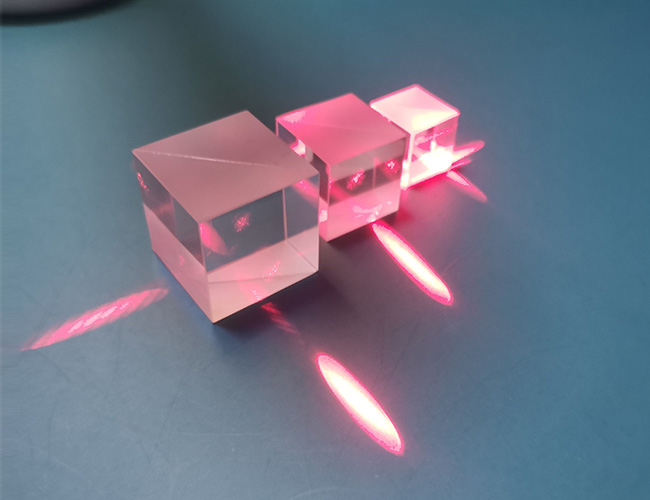ISO9001 Certified Professional Manufacturer & Supplier of Optics
+86-0431-87911611 admin@ytoptics.com
Contact us
-
 Email: admin@ytoptics.com
Email: admin@ytoptics.com
-
 Tel:86-0431-87911611
Tel:86-0431-87911611
-
 Add: 2# Automotive Innovation
Add: 2# Automotive Innovation
Jilin Province, China
Changchun Yutai Optics Co., Ltd.
Home > Products > Prisms > Beamsplitters

Cube Beamsplitter
A beamsplitter is a core element of an optical system used to split incident light into two beams (reflection and transmission) in a specific ratio. Depending on the principle of beamsplitting, materials, and coatings, they can be divided into various types.
Share this:
Difference between Beamsplitter, Polarizing Beamsplitter and Non-Polarizing Beamsplitter
Beamsplitter: sensitive to incident polarization, the angle of linear polarization affects the spectral ratio. If the incident light is natural light or circularly polarized light, the light will be split according to 50:50. Split beam when only share the energy, the ideal device under the two-way light polarization state or the original appearance of the incident light, the actual process defects will cause a little bit of de-polarization. Almost no absorption of light intensity.
Polarizing Beamsplitter: sensitive to incident polarization, the angle of linear polarization affects the spectral ratio. If the incident light is natural light or circularly polarized light, the light will be split according to 50:50. When splitting the beam, in addition to distributing energy, the two outgoing beams must be linearly polarized, and one beam is parallel linearly polarized and the other is perpendicularly linearly polarized, with the two linearly polarized directions differing by 90°.
Non-Polarizing Beamsplitter: insensitive to polarization, regardless of what the incident light polarization state will not affect the incident light splitting ratio, splitting ratio in any case is 50:50. Beam splitting time only split the energy, the ideal device out of the two light polarization state or the original, the actual process defects will cause a little bit back polarization. There is a certain absorption of light intensity.
Beamsplitter: sensitive to incident polarization, the angle of linear polarization affects the spectral ratio. If the incident light is natural light or circularly polarized light, the light will be split according to 50:50. Split beam when only share the energy, the ideal device under the two-way light polarization state or the original appearance of the incident light, the actual process defects will cause a little bit of de-polarization. Almost no absorption of light intensity.
Polarizing Beamsplitter: sensitive to incident polarization, the angle of linear polarization affects the spectral ratio. If the incident light is natural light or circularly polarized light, the light will be split according to 50:50. When splitting the beam, in addition to distributing energy, the two outgoing beams must be linearly polarized, and one beam is parallel linearly polarized and the other is perpendicularly linearly polarized, with the two linearly polarized directions differing by 90°.
Non-Polarizing Beamsplitter: insensitive to polarization, regardless of what the incident light polarization state will not affect the incident light splitting ratio, splitting ratio in any case is 50:50. Beam splitting time only split the energy, the ideal device out of the two light polarization state or the original, the actual process defects will cause a little bit back polarization. There is a certain absorption of light intensity.
| Cube Beamsplitter | |
| Material | BK7 or Fused Silica |
| Dimension | 10/12/12.7/15/20/25/25.4mm |
| S/D | 80/50, 60/40, 40/20, 20/10, 10 |
| Angle Tolerance | 3secs-3mins |
| R/T Data | 10/90, 20/80, 30/70, 40/60, 50/50, 60/40, 70/30, 80/20 |
| Coating | beamsplitter&AR |
| Wavelength | VIS(400-700nm) |

TALK TO US 86-0431-87911611
86-0431-87911611
Call us now!
 86-0431-87911611
86-0431-87911611Call us now!
ONLINE CHAT
 2433808388
2433808388

